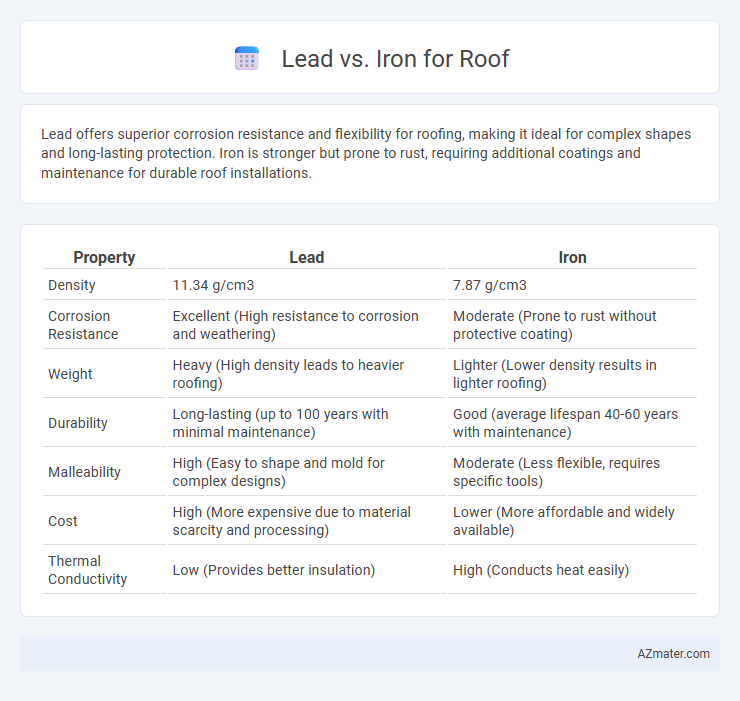Lead offers superior corrosion resistance and flexibility for roofing, making it ideal for complex shapes and long-lasting protection. Iron is stronger but prone to rust, requiring additional coatings and maintenance for durable roof installations.
Table of Comparison
| Property | Lead | Iron |
|---|---|---|
| Density | 11.34 g/cm3 | 7.87 g/cm3 |
| Corrosion Resistance | Excellent (High resistance to corrosion and weathering) | Moderate (Prone to rust without protective coating) |
| Weight | Heavy (High density leads to heavier roofing) | Lighter (Lower density results in lighter roofing) |
| Durability | Long-lasting (up to 100 years with minimal maintenance) | Good (average lifespan 40-60 years with maintenance) |
| Malleability | High (Easy to shape and mold for complex designs) | Moderate (Less flexible, requires specific tools) |
| Cost | High (More expensive due to material scarcity and processing) | Lower (More affordable and widely available) |
| Thermal Conductivity | Low (Provides better insulation) | High (Conducts heat easily) |
Introduction to Roofing Materials: Lead vs Iron
Lead roofing offers exceptional durability, corrosion resistance, and malleability, making it ideal for detailed architectural features and long-lasting protection. Iron roofing provides high strength and impact resistance but requires treatment or coatings to prevent rust and corrosion over time. Both materials serve distinct purposes in roofing applications, with lead favored for flexibility and longevity, while iron is chosen for structural robustness.
Historical Use of Lead and Iron in Roofing
Lead roofing has a rich history dating back to Roman times, prized for its durability, malleability, and resistance to corrosion, making it ideal for intricate roof designs and long-lasting protection. Iron, especially wrought iron, became prominent in roofing during the Industrial Revolution, valued for its strength and ability to support heavy structures, though it requires protective coatings to prevent rust. Historical structures across Europe showcase lead roofs on cathedrals and iron frameworks supporting slate or tile roofs, reflecting the evolving architectural technologies and material preferences through centuries.
Physical Properties: Lead Compared to Iron
Lead exhibits a density of approximately 11.34 g/cm3, significantly higher than iron's 7.87 g/cm3, resulting in a heavier but more malleable material suitable for roofing applications requiring complex shapes. Its low melting point around 327degC allows easy molding, while iron's higher melting point near 1538degC necessitates more intensive fabrication processes. Lead's superior corrosion resistance compared to iron, which is prone to rust without proper treatment, makes lead preferable for long-lasting weatherproof roofing installations.
Durability and Longevity of Lead and Iron Roofs
Lead roofs offer exceptional durability due to their natural resistance to corrosion, often lasting over 100 years with minimal maintenance, making them ideal for long-term applications. Iron roofs, while strong and more cost-effective initially, typically have a lifespan of 20 to 50 years depending on protective coatings and environmental factors, as they are prone to rust and require regular upkeep. The superior longevity of lead, combined with its ability to conform to complex roof shapes without compromising waterproofing, makes it a preferred material for heritage and high-end roofing projects.
Weather Resistance: How Lead and Iron Perform
Lead provides exceptional weather resistance for roofing due to its natural ability to withstand extreme temperatures, corrosion, and moisture without deteriorating. Iron, while strong and durable, is prone to rust and corrosion unless treated with protective coatings, which require regular maintenance to ensure longevity. The inherent weather-resistant properties of lead make it a preferred choice for roofing in harsh climates where durability against rain, snow, and temperature fluctuations is critical.
Installation Methods for Lead and Iron Roofs
Lead roofing installation requires precise overlapping and soldering of thin sheets to create a watertight seal, often applied over a timber deck with nails or adhesives. Iron roofing typically involves fixing corrugated or standing seam panels to metal or timber purlins using screws with rubber washers to prevent leaks, enabling faster and less labor-intensive installation. Proper substrate preparation and attention to thermal expansion are crucial for both materials to ensure durability and weather resistance.
Environmental Impact: Lead vs Iron Roofing
Lead roofing poses significant environmental risks due to its toxicity and potential for soil and water contamination from weathering and runoff. Iron roofing offers a more sustainable alternative, characterized by high recyclability and a lower ecological footprint throughout its lifecycle. Choosing iron over lead roofing supports environmental conservation by minimizing hazardous waste and promoting resource efficiency.
Cost Comparison: Lead Roofing vs Iron Roofing
Lead roofing costs significantly more than iron roofing due to its higher material price and specialized installation requirements. Iron roofing offers a cost-effective alternative with lower upfront expenses and easier installation, making it popular for budget-conscious projects. Over time, lead's durability and resistance to corrosion may justify the initial investment, while iron may require more maintenance and potential replacement.
Maintenance Requirements for Lead and Iron Roofs
Lead roofs require minimal maintenance due to their natural resistance to corrosion, lasting over a century with occasional inspections for punctures or joint integrity. Iron roofs need regular upkeep, including cleaning to prevent rust, periodic repainting, and prompt repairs of scratches or dents to maintain their protective coating. Proper maintenance of iron roofing typically extends its lifespan to 20-50 years, whereas lead roofing consistently outperforms in durability with less frequent intervention.
Choosing Between Lead and Iron: Which is Best for Your Roof?
Choosing between lead and iron for roofing depends on durability, weight, and weather resistance. Lead offers excellent corrosion resistance and malleability, making it ideal for complex roof shapes and long-lasting protection, while iron is stronger and more cost-effective but prone to rust without proper maintenance. Consider the climate, budget, and roof design to determine whether lead's longevity or iron's strength suits your roofing needs best.

Infographic: Lead vs Iron for Roof
 azmater.com
azmater.com